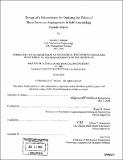| dc.contributor.advisor | Roger D. Kamm and Jeffrey T. Borenstein. | en_US |
| dc.contributor.author | Blundo, Jennifer T. (Jennifer Tryggvi), 1980- | en_US |
| dc.contributor.other | Massachusetts Institute of Technology. Dept. of Mechanical Engineering. | en_US |
| dc.date.accessioned | 2005-09-26T20:45:57Z | |
| dc.date.available | 2005-09-26T20:45:57Z | |
| dc.date.copyright | 2004 | en_US |
| dc.date.issued | 2004 | en_US |
| dc.identifier.uri | http://hdl.handle.net/1721.1/28496 | |
| dc.description | Thesis (S.M.)--Massachusetts Institute of Technology, Dept. of Mechanical Engineering, 2004. | en_US |
| dc.description | Includes bibliographical references (p. 141-146). | en_US |
| dc.description.abstract | Understanding blood vessel formation has become a principal, yet challenging, objective of bioengineering over the last decade. Unraveling the complex mechanisms of angiogenesis could lead to the development of pro or anti-angiogenic treatments for diseases like heart disease and cancer, as well as to the development of viable scaffolds for tissue engineering and biosensors. In pursuit of an optimal in vitro model to study angiogenesis, the aim of this thesis is to design and fabricate a microscale bioreactor to study the effect of shear stress on angiogenesis using a microfabricated substrate, a self-assembling peptide gel, and bovine aortic endothelial cells. A theoretical model was developed to approximate the permeability of the peptide gel and to quantify the average shear stress on an endothelial cell seeded in a 3D matrix of the peptide gel. Experimental results in a macroscale system demonstrate endothelial cell lumen formation and elongation in the direction of interstitial flow in response to physiological levels of shear stress [approximately] 10 dynes/cm², as well as increased cell viability; negligible shear control samples demonstrate no lumen formations and lower cell density. In order to gain more insight on the complex mechanisms of angiogenesis, the proposed microscale device closely mimics in vivo conditions and allows for real time imaging and monitoring of endothelial cell migration and network formation. The device has the potential to investigate the synergistic effects of mechanical and biological factors, including varying levels of shear stress and the delivery of chemoattractants or angiogenic factors. The experimental setup incorporated optimizing the geometry of the microfluidic channels, the protocols for cell imaging, | en_US |
| dc.description.abstract | (cont.) and the techniques for forming peptide gel in the device. The results of experiments with the peptide gel and endothelial cells in the device exhibit promising scaffolds for regions of 3D cell culture under interstitial flow. | en_US |
| dc.description.statementofresponsibility | by Jennifer T. Blundo. | en_US |
| dc.format.extent | 152 p. | en_US |
| dc.format.extent | 7077627 bytes | |
| dc.format.extent | 7097405 bytes | |
| dc.format.mimetype | application/pdf | |
| dc.format.mimetype | application/pdf | |
| dc.language.iso | en_US | |
| dc.publisher | Massachusetts Institute of Technology | en_US |
| dc.rights | M.I.T. theses are protected by copyright. They may be viewed from this source for any purpose, but reproduction or distribution in any format is prohibited without written permission. See provided URL for inquiries about permission. | en_US |
| dc.rights.uri | http://dspace.mit.edu/handle/1721.1/7582 | |
| dc.subject | Mechanical Engineering. | en_US |
| dc.title | Design of a microreactor for studying the effect of shear stress on angiogenesis in self-assembling peptide matrix | en_US |
| dc.type | Thesis | en_US |
| dc.description.degree | S.M. | en_US |
| dc.contributor.department | Massachusetts Institute of Technology. Department of Mechanical Engineering | |
| dc.identifier.oclc | 57306282 | en_US |
